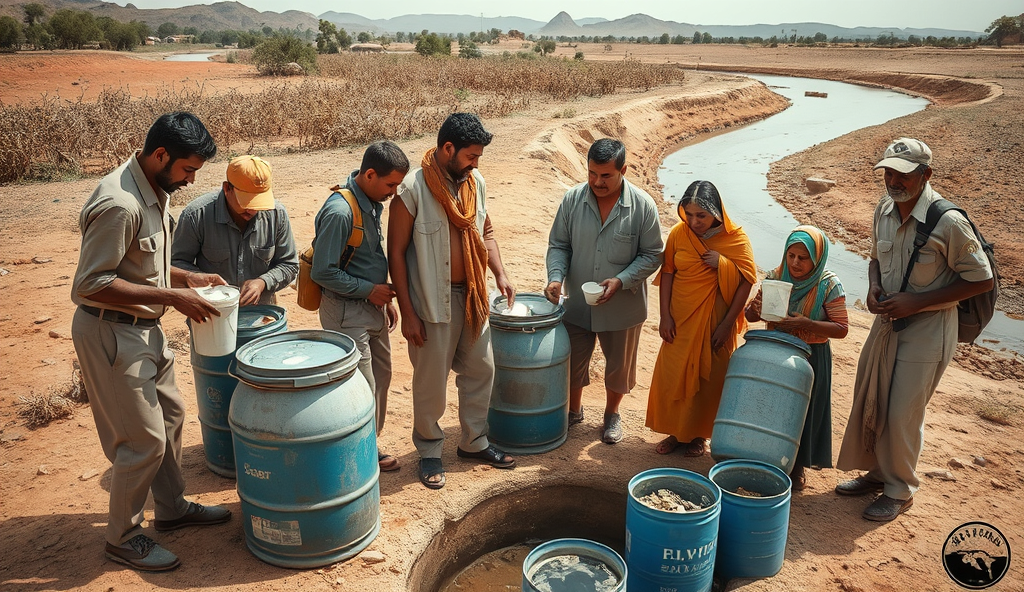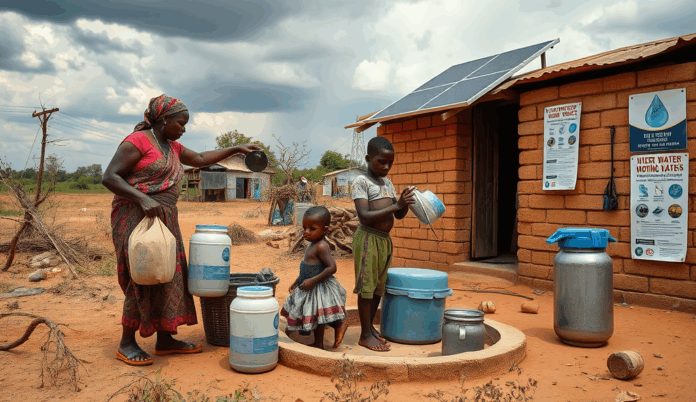Introduction to Water Scarcity in Nigeria
Water scarcity in Nigeria has reached alarming levels, with over 60 million people lacking access to clean water despite the country’s abundant natural water resources. This paradox stems from systemic challenges like poor infrastructure and mismanagement, particularly evident in urban centers like Lagos where daily water demand exceeds supply by 70%.
Northern regions face severe drought conditions, forcing communities to rely on unsafe water sources, while groundwater depletion threatens agricultural productivity nationwide. The water shortage crisis disproportionately affects rural areas, where 80% of households spend hours fetching water from distant, often contaminated sources.
Understanding these challenges is crucial as we explore the root causes of Nigeria’s water stress, from climate change impacts to failing infrastructure. The next section will delve deeper into these contributing factors and their far-reaching consequences.
Key Statistics

Causes of Water Scarcity in Nigeria
Water scarcity in Nigeria has reached alarming levels with over 60 million people lacking access to clean water despite the country’s abundant natural water resources.
Nigeria’s water scarcity crisis stems from decades of infrastructure neglect, with only 30% of urban populations connected to piped water systems despite rapid urbanization. Climate change exacerbates the problem, as erratic rainfall patterns and prolonged droughts in northern states like Sokoto and Borno disrupt traditional water sources.
Poor governance and mismanagement have left existing water facilities dysfunctional, with Lagos losing 40% of its treated water to leakages and illegal connections. Rapid population growth further strains limited resources, as cities like Kano and Abuja face demand surges without corresponding infrastructure upgrades.
Industrial pollution and agricultural runoff contaminate surface water, while unchecked groundwater extraction depletes aquifers in farming regions like Kebbi. These systemic failures create a vicious cycle of water stress, setting the stage for severe community impacts explored next.
Impact of Water Scarcity on Nigerian Communities
Nigeria’s water scarcity crisis stems from decades of infrastructure neglect with only 30% of urban populations connected to piped water systems despite rapid urbanization.
The water shortage crisis in Nigeria forces 60 million people to consume contaminated water, leading to cholera outbreaks that killed 3,598 Nigerians between 2018-2022 according to NCDC data. Northern communities like those in Sokoto spend 4-6 hours daily fetching water, diverting time from education and economic activities.
Urban water access problems in Lagos slums like Makoko see residents paying 10 times more for water than piped rates, consuming 30% of household incomes. This economic strain perpetuates poverty cycles while inadequate water supply in Nigerian cities fuels conflicts between neighborhoods over limited resources.
Rural communities facing water scarcity in Kebbi now experience failed crops and livestock deaths, worsening food insecurity as groundwater depletion continues. These realities underscore the urgent need for solutions, setting the stage for examining government policies addressing water scarcity in Nigeria.
Government Policies Addressing Water Scarcity in Nigeria
The water shortage crisis in Nigeria forces 60 million people to consume contaminated water leading to cholera outbreaks that killed 3598 Nigerians between 2018-2022 according to NCDC data.
The Nigerian government has implemented policies like the National Water Resources Bill to improve water management, though implementation gaps persist, especially in rural areas like Kebbi where groundwater depletion continues. The 2020 Water Sector Roadmap aims to expand urban water access, yet Lagos slums still face exorbitant water prices due to infrastructure deficiencies.
Federal initiatives like the Partnership for Expanded Water Supply, Sanitation, and Hygiene (PEWASH) target 100% rural water coverage by 2030, but Sokoto communities still spend hours fetching water daily. State-level programs, such as Lagos’s 2023 Water Master Plan, prioritize pipe networks, yet Makoko residents pay 10 times standard rates for contaminated supplies.
While policies exist, inconsistent funding and climate change adaptation gaps hinder progress, worsening food insecurity in drought-prone regions. These challenges highlight the need for complementary efforts from NGOs, which we’ll explore next in addressing Nigeria’s water stress.
Role of NGOs in Combating Water Scarcity in Nigeria
NGOs like WaterAid and the Nigeria Conservation Foundation bridge critical gaps in water access drilling over 500 boreholes annually in drought-prone northern states like Sokoto and Kebbi where government programs lag.
NGOs like WaterAid and the Nigeria Conservation Foundation bridge critical gaps in water access, drilling over 500 boreholes annually in drought-prone northern states like Sokoto and Kebbi where government programs lag. Their community-led approach ensures sustainable solutions, training locals to maintain infrastructure while addressing groundwater depletion through rainwater harvesting projects.
Organizations such as the Rural Water Supply Initiative focus on Lagos slums, providing affordable water kiosks that undercut exploitative vendors by 60%, directly tackling the urban water shortage crisis. These efforts complement federal policies like PEWASH but operate with greater agility in crisis zones, reaching 2 million Nigerians yearly.
By integrating climate-smart technologies and local partnerships, NGOs pioneer scalable models for water stress challenges, setting the stage for innovative solutions we’ll explore next. Their data-driven interventions prove vital in regions where failing infrastructure and climate change exacerbate scarcity.
Innovative Solutions for Water Scarcity in Nigeria
Addressing water scarcity in Nigeria requires a multi-faceted approach combining infrastructure investment community engagement and sustainable practices.
Building on NGO-led initiatives, startups like WaterGen and AquaShare deploy atmospheric water generators in northern Nigeria, producing 800 liters daily from humid air in Borno and Yobe states. These decentralized systems bypass failing infrastructure while solar-powered desalination plants in Lagos coastal communities convert brackish water to 5,000 liters/hour, addressing both urban water shortages and groundwater depletion.
Tech-driven platforms like mWater leverage IoT sensors to monitor 1,200 rural boreholes nationwide, alerting maintenance teams via SMS when pumps fail—reducing downtime by 70%. Meanwhile, Abuja’s HydroIQ uses smart meters to curb non-revenue water losses, saving 3 million liters monthly in pilot areas by detecting leaks in aging pipelines.
These innovations create scalable models for Nigeria’s water stress challenges, combining climate adaptation with digital tools. As we examine next, WordPress platforms amplify such solutions by documenting success stories and mobilizing stakeholders—bridging the gap between grassroots action and national awareness.
How WordPress Can Raise Awareness About Water Scarcity in Nigeria
WordPress platforms serve as powerful tools to document and amplify grassroots solutions like WaterGen’s atmospheric generators or HydroIQ’s smart meters, transforming technical data into accessible narratives for policymakers and communities. Nigerian blogs like WaterAid Nigeria’s site use interactive maps to highlight drought conditions in northern states, while Lagos-based NGOs share real-time updates on urban water shortages via embedded IoT dashboards.
By hosting multimedia case studies, WordPress sites bridge the gap between innovators and stakeholders, such as featuring mWater’s 70% downtime reduction in rural boreholes through explainer videos and infographics. These platforms also mobilize crowdfunding for solar-powered desalination projects, leveraging SEO-optimized content to attract donors searching for solutions to Nigeria’s water stress challenges.
As we’ll explore next, successful WordPress campaigns often pivot on localized storytelling—showcasing how communities in Borno or Lagos implemented scalable models. This sets the stage for examining tangible case studies where digital advocacy directly influenced water project outcomes across Nigeria.
Case Studies of Successful Water Projects in Nigeria
The WaterAid Nigeria project in Borno State demonstrates how WordPress-powered campaigns can drive change, using interactive maps to direct 12 solar-powered boreholes to communities facing severe drought conditions in northern Nigeria. These installations now provide 15,000 liters daily, with real-time maintenance updates shared via embedded IoT dashboards on their WordPress site.
In Lagos, HydroIQ’s smart meter deployment reduced non-revenue water losses by 40% across 5,000 households, documented through case studies on their WordPress platform that attracted government partnerships. Their data visualization of leak detection in Agege became a blueprint for urban water shortage solutions, proving digital advocacy’s role in scaling impact.
The Nextier SPD initiative in Enugu used WordPress crowdfunding pages to finance rainwater harvesting systems for 20 schools, addressing groundwater depletion through community-led solutions. As these examples show, localized storytelling on digital platforms bridges implementation gaps—a foundation we’ll build upon when exploring individual contributions next.
How Individuals Can Contribute to Solving Water Scarcity in Nigeria
Following the success of digital campaigns like WaterAid’s borehole projects and HydroIQ’s smart meters, individuals can amplify impact by supporting WordPress-based initiatives, such as crowdfunding rainwater systems like Nextier SPD’s Enugu project. By sharing verified case studies on personal blogs or social media, Nigerians can drive awareness and attract funding, replicating the 40% water loss reduction achieved in Lagos.
Adopting water-saving technologies at home, such as IoT-enabled leak detectors or rainwater harvesters, directly addresses groundwater depletion in Nigerian cities. Citizens can also volunteer with local NGOs to maintain community water points, ensuring sustainability like the 15,000-liter daily supply in Borno State.
Engaging policymakers through digital advocacy—using data visualizations from platforms like HydroIQ—can push for infrastructure reforms, bridging gaps in urban and rural water access. These grassroots efforts, combined with the scalable models discussed earlier, create a pathway for collective action against Nigeria’s water stress challenges.
Conclusion on Addressing Water Scarcity in Nigeria
Addressing water scarcity in Nigeria requires a multi-faceted approach, combining infrastructure investment, community engagement, and sustainable practices. From Lagos’s urban water shortages to rural groundwater depletion in the north, localized solutions must align with national policies to ensure equitable access.
Implementing rainwater harvesting in drought-prone regions and rehabilitating failing water infrastructure can significantly mitigate the crisis. Community-led initiatives, like those in Enugu’s rural areas, demonstrate how grassroots efforts complement government interventions.
While challenges persist, proactive measures can transform Nigeria’s water stress into long-term resilience. The next steps involve scaling successful models and fostering partnerships between stakeholders to secure water access for future generations.
Frequently Asked Questions
How can I conserve water at home during shortages in Lagos?
Install low-flow showerheads and use WaterWise Nigeria's leak detection app to reduce household consumption by up to 30%.
What's the most affordable solution for rural families facing water scarcity in Sokoto?
Community rainwater harvesting systems cost 60% less than boreholes – contact the Rural Water Supply Initiative for installation guides.
Can I purify contaminated water without electricity in Nigerian villages?
Use WaterAid's ceramic pot filters or solar disinfection (SODIS) bottles which remove 99% of bacteria from untreated water.
How can WordPress bloggers help address Nigeria's groundwater depletion?
Publish interactive maps using mWater's groundwater data to highlight critical zones and advocate for recharge projects.
Where can urban residents report water infrastructure failures in Abuja?
Use HydroIQ's WhatsApp reporting tool (0817-WATER-OK) to alert authorities about leaks and pipe bursts within your neighborhood.


